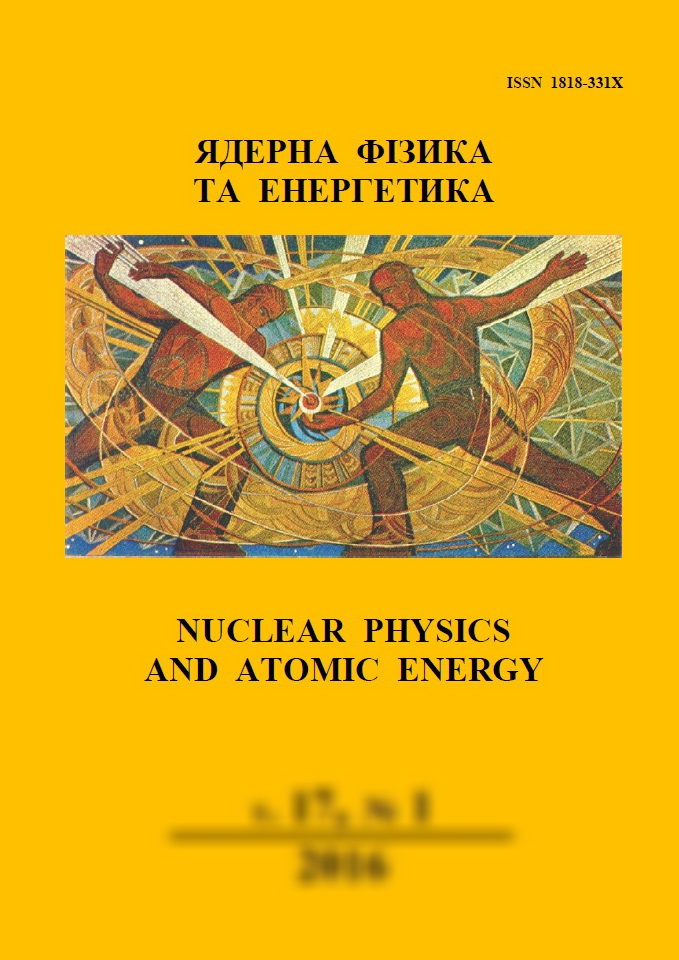 |
Ядерна фізика та енергетика
Nuclear Physics and Atomic Energy
ISSN:
1818-331X (Print), 2074-0565 (Online)
Publisher:
Institute for Nuclear Research of the National Academy of Sciences of Ukraine
Languages:
Ukrainian, English
Periodicity:
4 times per year
Open access peer reviewed journal
|
Nucl. Phys. At. Energy 2022, volume 23, issue 2, pages 131-139.
Section: Radiobiology and Radioecology.
Received: 11.06.2021; Accepted: 14.09.2022; Published online: 29.09.2022.
 Full text (ua)
Full text (ua)
https://doi.org/10.15407/jnpae2022.02.131
Effect of high energy electron exposure of the saline solution on physicochemical properties and cytotoxic activity of doxorubicin
M. A. Zabolotnyy1,*, L. I. Aslamova1, G. I. Dovbeshko2, O. P. Gnatyuk2, V. B. Neimash2, V. Yu. Povarchuk2, V. E. Orel3, D. L. Kolesnyk4, L. M. Kirkilevska5, G. I. Solyanyk4
1 Taras Shevchenko National University of Kyiv, Kyiv, Ukraine
2 Institute of Physics, National Academy of Sciences of Ukraine, Kyiv, Ukraine
3 National Cancer Institute, Kyiv, Ukraine
4 R. E. Kavetsky Institute of Experimental Pathology, Oncology and Radiobiology, National Academy of Sciences of Ukraine, Kyiv, Ukraine
5 Kyiv Medical University, Ukrainian Association of Folk Medicine, Kyiv, Ukraine
*Corresponding author. E-mail address:
fedcba137@ukr.net
Abstract:
The effect of preliminary irradiation of an aqueous solution of sodium chloride (saline) with 1 MeV high-energy electron beams on optical and cytotoxic/cytostatic properties of the dissolved Doxorubicin cancer drug is studied. With the use of Lewis lung carcinoma cell culture, it has been shown that the said treatment results in an increased cytotoxic/cytostatic action of the Doxorubicin, being the most pronounced in the range of low concentrations of the drug. The delivered dose of ionizing radiation on the saline ranged from 4 to 80 kGy. The maximum changes in the IR absorption spectra of Doxorubicin have been observed for the solutions irradiated with 10 kGy. The possible causes of the observed effects are discussed.
Keywords:
Doxorubicin, saline, high-energy electrons, delivered dose, IR absorption spectra, Lewis lung carcinoma.
References:
1. K. Nurgali, R. Thomas Jagoe, R. Abalo. Editorial: Adverse Effects of Cancer Chemotherapy: Anything New to Improve Tolerance and Reduce Sequelae? Front. Pharmacol. 9 (2018) 245.
https://doi.org/10.3389/fphar.2018.00245
2. N. Vasan, J. Baselga, D.M. Hyman. A view on drug resistance in cancer. Nature 575 (2019) 299.
https://doi.org/10.1038/s41586-019-1730-1
3. G. Mitola, P. Falvo, F. Bertolini. New Insight to Overcome Tumor Resistance: An Overview from Cellular to Clinical Therapies. Life 11(11) (2021) 1131.
https://doi.org/10.3390/life11111131
4. G. Housman et al. Drug Resistance in Cancer: An Overview. Cancers 6(3) (2014) 1769.
https://doi.org/10.3390/cancers6031769
5. K. Bukowski, M. Kciuk, R. Kontek, Mechanisms of Multidrug Resistance in Cancer Chemotherapy. Int. J. Mol. Sci. 21(9) (2020) 3233.
https://doi.org/10.3390/ijms21093233
6. D. Kumar. Nanoparticulate system for cancer therapy: An updated review. Journal of Nanomedicine Research 7(4) (2018) 262.
https://doi.org/10.15406/jnmr.2018.07.00197
7. D.G. Kirsch et al. The Future of Radiobiology. Journal of the National Cancer Institute 110(4) (2018) 329.
https://doi.org/10.1093/jnci/djx231
8. M.A. Zabolotnyy et al. Modification of anticancer drugs with nanostructures. Nanosystemy, Nanomaterialy, Nanotekhnolohiyi 13(1) (2015) 1. (Ukr)
https://www.imp.kiev.ua/nanosys/media/pdf/2015/1/nano_vol13_iss1_p0001p0014_2015.pdf
9. M.A. Zabolotnyy et al. The method of modification of water-soluble anticancer drugs using radiation exposure. Patent UA No. 116227. Published on February 26, 2018, Bull. No. 4
https://iprop-ua.com/inv/pdf/sbascz1v-pub-description.pdf
10. J.M. Grogan et al. Bubble and Pattern Formation in Liquid Induced by an Electron Beam. Nano Lett. 14(1) (2014) 359.
https://doi.org/10.1021/nl404169a
11. S. Rivankar. An overview of doxorubicin formulations in cancer therapy. J. Cancer Res. Ther. 10(4) (2014) 853.
https://doi.org/10.4103/0973-1482.139267
12. L.I. Aslamova et al. Electron irradiation as a method of increasing efficacy of some water soluble drugs in oncology. In: Proc. of the 14-th Int. Conf. “Medical Physics in the Baltic States”, Kaunas, Lithuania, November 7 - 9, 2019 (Kaunas, University of Technology, 2019) p. 151.
http://www.medphys.lt/medphys2019/images/MedPhys2019_Proceedings.pdf
13. V.B. Orel, M.A. Zabolotny, V.E. Orel. Heterogeneity of hypoxia in solid tumours and mechanochemical reactions with oxygen nanobubbles. Medical Hypotheses 102 (2017) 82.
https://doi.org/10.1016/j.mehy.2017.03.006
14. S. Sanyal et al. Designing Injection Water for Enhancing Oil Recovery from Kaolinite Laden Hydrocarbon Reservoirs: A Spectroscopic Approach for Understanding Molecular Level Interaction during Saline Water Flooding. Energy Fuels 31(11) (2017) 11627.
https://doi.org/10.1021/acs.energyfuels.7b01648
15. N.F. Bunkin et al. Investigation of the nanobubble phase of NaCl aqueous solutions by dynamic light scattering. Kvantovaya Elektronika 44(11) (2014) 1022. (Rus)
http://www.mathnet.ru/links/d75365ab6da584db9820368f49391c52/qe16063.pdf
16. L.M. Babkov et al. IR spectroscopy of molecular crystals with hydrogen bonds (Kyiv: Naukova Dumka, 1989) 160 p. (Rus)
17. O. Gnatyuk et al. Comparison of the Effect of High-Energy Ionizing Radiation and Hydrogen Peroxide on the Conformational Dynamics of DNA. Thai Journal of Nanoscience and Nanotechnology 2(2) (2017) 7.
http://www.nano.kmitl.ac.th/tjnn/index.php/tjnn/article/view/18/15
18. D.M. Hrodzynskyy. Radiobiology (Kyiv: Lybid, 2000) 447 p. (Ukr)
19. N.F. Bunkin, A.V. Lobeev. Fractal structure of bubbston clusters in water and aqueous electrolytic solutions. JETP Letters 58(2) (1993) 91.
http://jetpletters.ru/ps/1203/article_18174.shtml
20. Y. Mao, Y. Zhang. Nonequilibrium Molecular Dynamics Simulation of Nanobubble Growth and Annihilation in Liquid Water. Nanoscale and Microscale Thermophysical Engineering 17(2) (2013) 79.
https://doi.org/10.1080/15567265.2012.760692
21. N.F. Bunkin, F.V. Bunkin. Bubston structure of water and electrolyte water solutions, Uspekhi Fizicheskikh Nauk 186(9) (2016) 933.
https://doi.org/10.3367/UFNr.2016.05.037796
22. A.I. Momot, A.G. Zagorodny, I.S. Orel. Interaction force between two finite-size charged particles in weakly ionized plasma. Phys. Rev. E 95(1) (2017) 013212.
https://doi.org/10.1103/PhysRevE.95.013212
23. C.G. Gray, P.J. Stiles. Nonlinear electrostatics: the Poisson-Boltzmann equation. European Journal of Physics 39(5) (2018) 053002.
https://doi.org/10.1088/1361-6404/aaca5a
